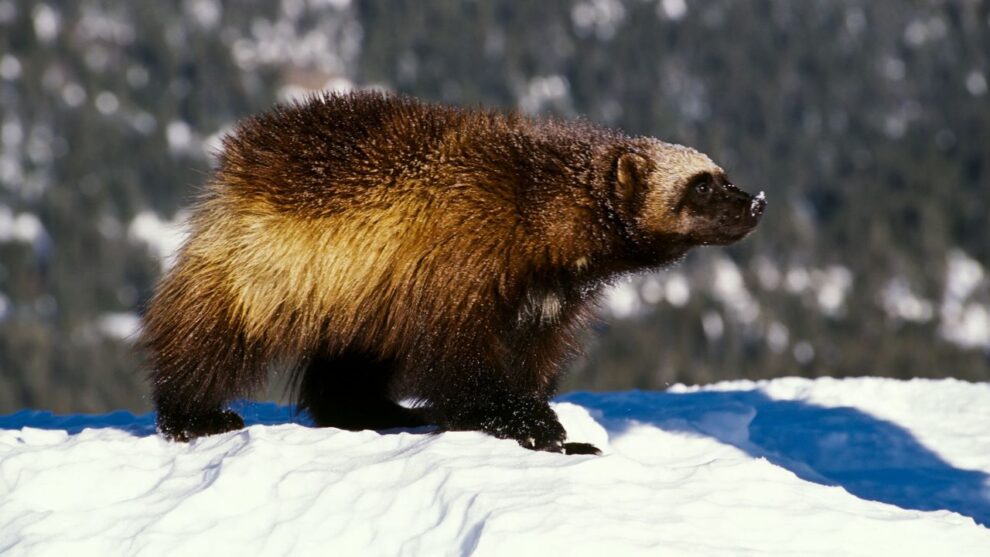Wolverines in the contiguous United States are threatened by climate change and habitat fragmentation and will be listed under the Endangered Species Act, the federal government announced Wednesday.
The largest terrestrial member of the weasel family, wolverines are famously fierce for their size. While scientists say they never existed in large numbers south of Canada, only an estimated 300 remain, inhabiting areas of the Northern Rocky Mountains and Northern Cascades of Montana, Idaho, Wyoming, Washington and Oregon.
“The wolverine’s adapted and has evolved in cold, snowy conditions,” said Jesse D’Elia, a biologist with the United States Fish and Wildlife Service who worked on the latest review of the species’ status. “As these conditions continue to change in the Western U.S., the outlook for wolverines is less secure than we found in our previous assessments.”
In the last decade, federal officials have seesawed over whether American wolverines should be protected outside Alaska, where their populations remain healthy. Three years ago, under the Trump administration, they ruled that wolverines should not be. But a judge vacated that decision last year, requiring the Fish and Wildlife Service to reconsider.
The opposite finding this time is because of new research, federal officials said. To remain viable, wolverines in the lower 48 states must be connected with those in southern Canada. An important Canadian population appears to have declined, they noted, and roads are preventing females from dispersing into the United States.
The officials cited a comprehensive genetic analysis completed this year on wolverines on both sides of the border that raised concerns about low genetic diversity in the animals living to the south. And new studies on the impacts of backcountry winter recreation suggested that such activities were driving away wolverines. Habitat loss could be magnified as snowy areas shrink, further concentrating skiers, snowmobilers and wolverines.
Climate change modeling has predicted reductions of spring snow in the breeding range of wolverines. That’s a problem because, in the alpine habitats where wolverines live in the contiguous United States, females make dens from spring snow to give birth, Dr. D’Elia said. The animals also rely on cold temperatures to refrigerate the food they scavenge off large carcasses and cache for later.
The move to protect wolverines is the culmination of a quarter century campaign and legal battle by a coalition of wildlife advocates. They applauded the decision, expressing hope that it would help wolverines survive and recover, as well as disappointment that it had taken so long.
“I’m relieved that they’re finally following the science,” said Andrea Zaccardi, legal director of carnivore conservation at the Center for Biological Diversity, one of the groups that has sued repeatedly for wolverine protection.
Ms. Zaccardi blamed politics for lost time, pointing to longstanding tensions between state and federal governments.
”The states obviously never want wildlife listed because they want to manage their own species in their boundaries,” she said.
In 2013, the Fish and Wildlife Service proposed protecting wolverines before reversing course the following year. Officials said they were following the science, but a federal judge wrote in a scathing 2016 ruling that it appeared otherwise, citing “the immense political pressure” brought to bear by the states in question.
Last year, in a response to federal wildlife officials, the state of Idaho argued that wolverines there and in adjacent states were secure as a result of conservation efforts combined with the species’ “remarkable ability to disperse and recolonize suitable habitat from which it had been extirpated.”
Wolverines were all but eliminated in the West by 1920 because of poisoning, trapping and starvation, but numbers have since increased.
Farm bureaus, the fossil fuel industry and snowmobile associations have also opposed protection for wolverines. The American Farm Bureau Federation and the Independent Petroleum Association of America did not immediately respond to requests for comment on the new decision.
Federal agencies like the Forest Service and Bureau of Land Management will have to consult with the Fish and Wildlife Service if they are considering activities on public lands that could harm wolverines.
The decision includes an interim rule that makes exemptions for cases in which people accidentally harm wolverines while lawfully trapping for other species, as well as for forest management to reduce wildfire risk. Federal officials said those activities were not likely to harm the species’ conservation.
But Ms. Zaccardi of the Center for Biological Diversity said she was concerned about those exemptions. Recent changes in Idaho and Montana that allow baiting and snaring of wolves could increase the risk of trapping to wolverines, she said. And she said logging could be justified as wildfire reduction, so she urged more narrow language.
Wolverines are to be formally added to the endangered list 30 days after the publication of the rule on Thursday. The exceptions laid out in the interim rule are subject to a 60-day public comment period, which also begins on Thursday, and they could be revised.
Source: The New York Times
















